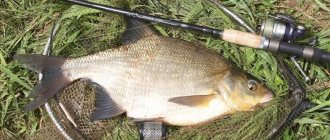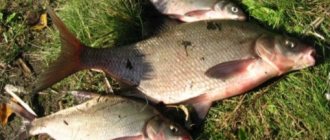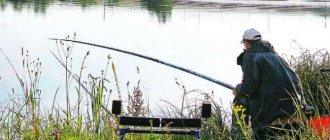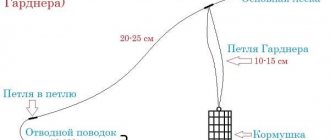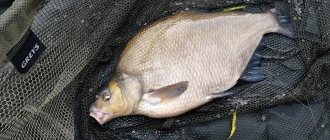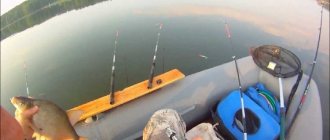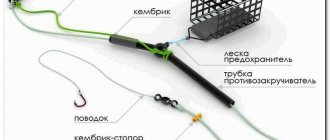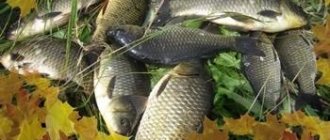November is the coldest autumn month, but despite the noticeable cooling, you can still catch heat-loving bream. The bite, of course, is no longer what it was at the beginning of autumn, but in the pre-winter period there is a high probability of catching a trophy specimen weighing over 3 kg. In November, bream comes out to feed for a short time, in bad weather only for about half an hour, but how much fun you can get by waiting for the desired bite and pulling a decent-sized fish ashore.
With the arrival of the November cold, peaceful fish feed only at certain times and behave extremely carefully. Bream is no exception. It can no longer be found in summer camps; now it is located at great depths and does not move far from the wintering pits. But even if the angler finds such a place, there is no guarantee that the fish will bite, since at this time of year its appetite depends on many factors. And first of all, on the water temperature. Catching bream in November requires a great deal of patience and knowledge of its late-season habits. The key to successful fishing will also be a competent choice of fishing location and baits, preparation of bait that can attract fish, and correct installation of equipment that transmits the most careful bite.
⚓ Where to look for the handsome river
In November, bream concentrate near wintering pits in areas with a relief bottom. They no longer enter the coastal zone, so fishing at shallow and medium depths will be fruitless. You can count on successful fishing in those places where the depth begins just below the shore. The nature of the bottom surface is of great importance when fishing for bream in November. It is known that at any time of the year this fish prefers to stay above a muddy or rocky bottom, and avoids sandy bottoms. And if in the summer months you can still accidentally catch it on the “sand”, then at the end of autumn such “gifts” practically do not happen.
If promising depths are located far from the shore, and even with the longest cast you can’t reach them, then it makes sense to use a watercraft. True, in the cold November weather, not everyone can sit in a boat in the middle of an open space. We must not forget that in certain sections of rivers there may be a ban on fishing in wintering pits, violation of which is fraught with a serious fine.
Feeder fishing technique in autumn
Feeder fishing in the fall involves the use of thin and sensitive gear. It has some advantages over other gear - it has a sensitive tip. In autumn water, fish are not as active as in spring, and their resistance is less. You can use a thinner fishing line and leash. And the water is cleaner and lighter in the fall, a thick fishing line will be noticeable in the water.
But in the fall you have to fish far from the shore, throwing heavy feeders. And here there is no need to greatly reduce the fishing line, since you can lose half of the tackle when casting. You should also use forms up to 4 m in length or more.
After all, as the temperature drops, fish move further and further into wintering pits. When fishing with a feeder, you should use only a braided line; at a distance, it feels the bite better. Also, when casting long distances, it is better to use a feeder with rounded shapes to improve aerodynamic performance.
⚓ Fishing time and external factors
In cold weather, bream does not bite in the very morning, so there is no point in going to the river too early. Is it just to take the most promising place. A more or less stable bite begins no earlier than 10.00 and can continue until 13.00-14.00 if the weather does not make its own adjustments.
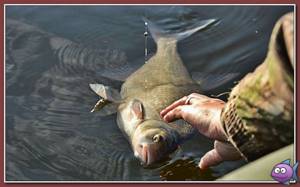
Weather conditions are the most important factor in November bream fishing. When there is no stability, the atmospheric pressure fluctuates, sometimes it rains, and the wind either rises or subsides, you can’t count on a good bite. And in general, at least for some. The object of fishing reacts very painfully to such phenomena and prefers to wait them out in the pits, completely refusing food.
It’s a completely different matter when stable sunny weather persists for 3-4 days. During such periods, the bream becomes more active, hunger forces it to look for food, and it willingly takes the bait offered by fishermen. While fishing you can see several confident bites, which is good news at the very end of autumn.
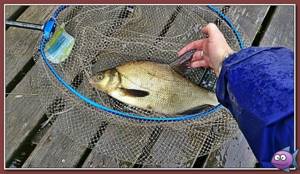
Large November bream
Large bream in November is not uncommon, the main thing is to know how to catch, where to catch and what to catch bream in November.
Let's try to analyze in this article all the intricacies of bream fishing specifically for one autumn month - November.
In November, the bream bite does not start in the morning; the fish become active around 10 o’clock.
This is due to the fact that the fish are not yet completely accustomed to temperature changes in the water.
But the bite is steady and continues throughout the day with varying success.
In addition, it is worth noting that when fishing for bream in November, there is a very high probability of catching quite large bream. Therefore, by choosing the right bait and bait, your catch can make you very happy.
⚓ Effective tackle
Most often, anglers practice catching bream in November on a feeder, since other gear is no longer relevant at this time. Only a bottom with a sinker can compete with it, but without an attractive bait mixture showing the way to the bait, catching bream in the pre-winter period is an unjustified task. The fish may simply not find the miniature bloodworm.
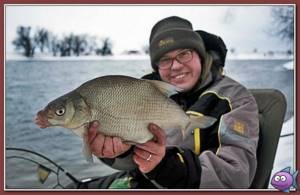
What should the feeder be like for fishing bream a few weeks before freeze-up? There are few places on rivers where the depth begins 2-3 meters from the shore, so a short rod is not enough. You need a long “stick” of at least 3 meters with a fast or medium-fast action, thanks to which the quivertip will clearly convey the accurate bites of the November bream. The test is selected taking into account the strength of the river current. In a weak stream you can fish with feeders weighing from 40 to 80 g, and in the rapids you will have to cast heavy analogues up to 150 g. For example, when fishing in a weak current and casting at a distance of up to 50 meters, you can use a rigid feeder rod 3.3 meters long with maximum test value 80 g.
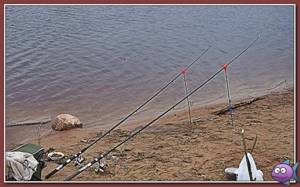
Now about the coils. The most important thing is that the reel matches the chosen rod and does not upset the balance of the tackle, otherwise it will be uncomfortable to use. Usually they use a spinning rod with a wide, capacious spool, which allows long casts. The reel must be checked before fishing. Friction brake, reverse stopper, line guide - all this should work like a Swiss watch. You can use a carp model with a baitrunner; this mechanism often helps out in trophy fishing.
Monofilament of a suitable diameter is used as the main fishing line. With a thin line, casting increases significantly, but it may not withstand the resistance of large fish. The thick one is reliable, but floats a lot in the current. Therefore, it is necessary to find the golden mean, and you need to look for it in the range from 0.25 to 0.35 mm. The recommended supply of fishing line is at least 80 meters.
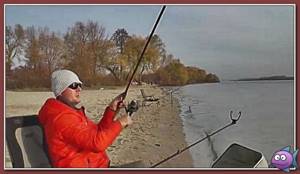
Installation of feeder equipment is classic. This can be a paternoster or an asymmetrical loop. It is important that the cautious bream does not feel any resistance when biting, and for this it is necessary to use long leashes (from 50 cm). The leash is made from monofilament fishing line (for example, fluorocarbon), invisible in clear water, with a slightly smaller diameter than the main one. The hook must be sharp and of such a size that a bunch of larvae (bloodworms, maggots) can be attached to it. The angler chooses the shape and volume of the feeder at his own discretion, taking into account the nature of the soil, the strength of the current and the activity of the object being fished.
Fishing for bream on a feeder in November
After the water temperature drops, the bream moves to the bottom depressions, in which it will remain during the freeze-up period. The activity of bream in November noticeably decreases, but it does not hibernate. In late autumn, bream does not go into shallow water and stays above the bottom surface. The fish continues to search for aquatic insects buried in a thin layer of silt. Fishing for bream on a feeder in November is the most promising in relation to other gear used for catching this fish.
In November, preference should be given to bait of animal origin. In addition to traditional fishing baits, peeled shrimp are used to catch bream. But don’t completely ignore plant baits. It is impossible to predict what will be best for biting bream on a fishing day in late autumn.
For fishing in November, it is advisable to use 3-5 gear. Casts are made throughout the entire available sector. Equipment consisting of several feeders increases the catchability of the feeder. To catch bream on a feeder in November, the so-called crucian killer rig is successfully used. But it is advisable to modify it a little: replace the 5-centimeter leashes with longer analogues, 20-50 cm long.
So, catching bream on a feeder in the fall is promising. The main thing is to properly prepare for fishing. Careful preparation is the key to receiving a lot of positive emotions.
⚓ What to use to catch sluggish autumn bream
In November, baits of animal origin work; grain baits during this period no longer give the same results as in the summer. Although there are exceptions, especially if the weather is more like September. The best bait, of course, is bloodworms, but on some days bream takes well on maggots. You can also try to seduce him with a nimble, delicious worm. Nobody forbids combining the listed baits either; if you are lucky enough to find a successful combination, excellent fishing is guaranteed.
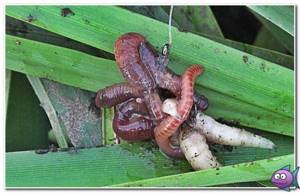
Some fishermen argue that even in cold water it makes sense to use attractants. The smells of dill, fish, shrimp, and blood will help make the bait more attractive. However, you need to understand that too strong a rich smell can both attract fish and scare it away.
⚓ Feeding bream in November
The bait used is simple, but effective. Some components can be found at home, others can be purchased at the store. It consists of:
- bread crumbs (30%);
- dry millet (30%);
- oatmeal porridge (10%);
- sunflower cake (10%);
- feed bloodworm (20%).
The last ingredient is required; without it, the bait will be ineffective or completely useless. If there are no bloodworms, you can replace them with crushed worms or, as a last resort, add one or two handfuls of maggots to the mixture. The components are mixed directly on the pond; river water is used for mixing, and the bait can be given a viscous consistency using soil taken from the shore.
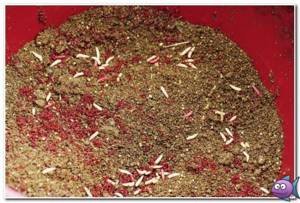
Bream fishing depending on the month of fishing
September
In September there is a very active bream bite.
Fishing on calm, clear days, especially early in the morning or late in the evening, before sunset, gives good results. In cloudy and windy weather, you can try your luck by finding a relatively calm place. When fishing for bream, it is very useful to use fine bait, which makes it possible to keep the bream in the place necessary for the fisherman for a long time, without allowing the fish to get enough.
In September, the following perform well as bait:
- worm;
- maggot;
- bread;
- dough (one type of dough is hominy);
- cereals;
Methods for planting maggots and bloodworms are described here.
The use of bait is very justified. Feed the same place every day. But to save time, you can simply fish in the same place for several days. This will definitely give a positive result.
October
In October there is a decrease in bream biting activity.
This is due to the accumulation of fat before cold weather, the bream is full and feeding lasts no more than 4 hours a day. At this time, the fish gather in schools and stay at a considerable depth, constantly moving around the reservoir.
In October, bream, as a rule, takes the bait that lies on the bottom, so the “helicopter and two knots” rig will be less appropriate. “Paternoster” or other bottom mounts will perform better.
Bait (animal components only):
- worm;
- bloodworm;
- less often maggot;
The bait must necessarily contain an animal component, or better yet be based on bloodworm extract. Bream in cold water prefer food with a predominantly protein component.
November
In November, the bream bite is unstable and you have to look for it in very deep areas.
You most likely won’t find it where you caught it in the summer. The pits near which it is located will be used by it in winter for wintering. The temperature in them does not drop to critically cold levels, and this allows you to endure the hardships of cold winters more calmly. We recommend using long feeders up to 4.2 meters for long casts and fishing in pools up to 15 meters deep. In order to find a place, you can use a marker float or a portable coastal echo sounder.
Bait - any bloodworms, maggots, but they need to be planted not in bunches, as in the summer, but in 1-2 larvae.
Groundbait - based on animal components for cold water. The easiest way is to buy it in a store; at home it is very difficult to prepare minced bloodworm. Give preference to the following brands: Dunaev, Trapper, Sensas.
‼ Useful tips
- The feeder for fishing bream should be configured in such a way that the fisherman sees the slightest touch of the fish to the bait. This is important because at the very end of the season the target is sluggish and indecisive and takes the bait very carefully.
- If there is no bite at a feeding point, this means only one thing - the place was chosen incorrectly. In late autumn, bream does not scour the reservoir in search of food, and it is unreasonable to wait for it. It is better to look for another promising point.
- The lower the water temperature, the fewer larvae there should be on the hook. Cold-shackled fish are not interested in bulky baits, but they can easily be tempted by one small bloodworm.
Features of the autumn feeder
When planning to go feeder fishing, you need to know its location in advance - it’s a river or a large lake. After all, in shallow water it is difficult to catch a large specimen. On a large area of water, you need to know places with holes, whirlpools, and snags.
It is more common to fish on narrow rivers, but the catches will be small. Fishermen who often go fishing pay their attention to the places where small rivers flow into wide rivers. There are sometimes great depths here, and the fish stand at the tributary in the hope of the food they bring.
In autumn, especially late, the fish choose their winter places. It is especially pleasant to catch bream and roach on the feeder in the fall. These are “classic” fish species; their behavior can be used to judge the bulk of the fish population.
September
The month is already marked by a drop in temperature. The water becomes clear due to the cessation of growth of aquatic plants. The fish begins to prepare for winter. On the borders of reeds and clear water you can also find pike. Later, when small and medium-sized fish move into the depths, the predator follows them. If an angler wants to catch burbot or pike perch, then they need to look for them in snags.
There are still warm days. At such times, you need to look for fish near the shore, near the fallen algae. As the temperature drops, all this water grass still falls to the bottom, and the fish moves to another place. For example, a pike gets hungry in winter and grabs everything. Without particularly choosing lures and bait.
In the fall, feeder fishing is good on medium rivers. Especially in the places where small ones meet large ones. In such places you can hope to catch chub and crucian carp. These fish do not leave their places as the temperature drops.
October
This month is famous for rain and cold winds. The fish goes deeper. But activity is high, and predators continue to eat. Until the very frosts, you can achieve success near reservoirs with steep banks with overhanging trees.
Places in creeks covered with fallen leaves are attractive for fish. There are roach, perch and rudd here. Bream and silver bream are found in the reservoirs. Their place is a riverbed edge, or a flat bottom with stones.
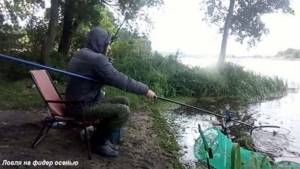
While at the reservoir, the angler must find a channel or hole; this is where fish are usually found. It will probably stand near fallen trees, stones and other obstacles if there is decent depth.
November
A feeder in November, if all fishing rules are followed, can be successful. True, the water temperature drops to +2-+4 degrees, and the activity of the fish decreases. It is located near the wintering pits; only selected bait will help make it take the bait.
The most important thing for feeder fishing at this time of year is choosing a place with the expected fish. For example, bream gathers in large schools and occupies deep places. But within a day, a school of bream can move several kilometers in search of food. Feeder fishing in late autumn can continue until freeze-up.
